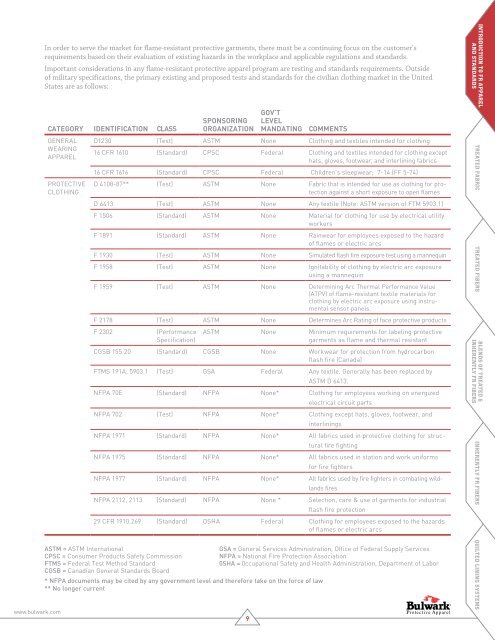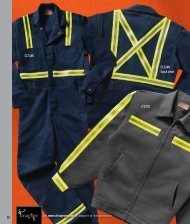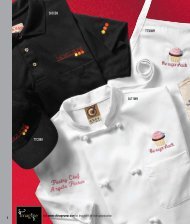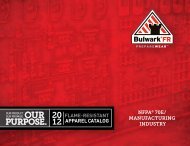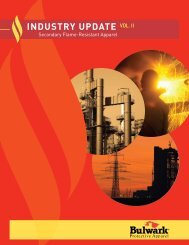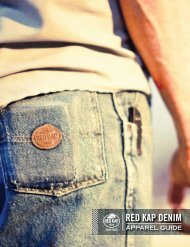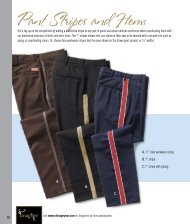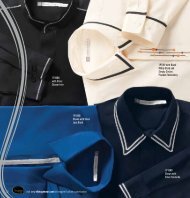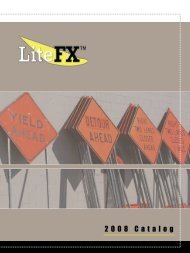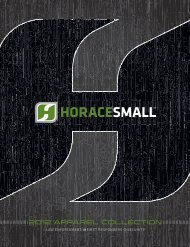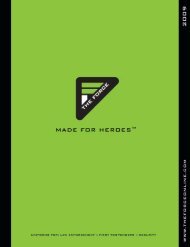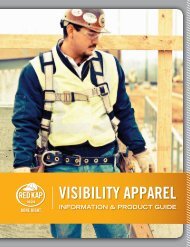VOL. 10 - Red Kap Work Clothes, Uniforms, & Coveralls
VOL. 10 - Red Kap Work Clothes, Uniforms, & Coveralls
VOL. 10 - Red Kap Work Clothes, Uniforms, & Coveralls
Create successful ePaper yourself
Turn your PDF publications into a flip-book with our unique Google optimized e-Paper software.
In order to serve the market for flame-resistant protective garments, there must be a continuing focus on the customer’s<br />
requirements based on their evaluation of existing hazards in the workplace and applicable regulations and standards.<br />
Important considerations in any flame-resistant protective apparel program are testing and standards requirements. Outside<br />
of military specifications, the primary existing and proposed tests and standards for the civilian clothing market in the United<br />
States are as follows:<br />
category identification class<br />
GENERAL<br />
WEARING<br />
APPAREL<br />
PROTECTIVE<br />
CLOTHING<br />
sponsoring<br />
organization<br />
gov’t<br />
level<br />
mandating<br />
comments<br />
D1230 (Test) ASTM None Clothing and textiles intended for clothing<br />
16 CFR 16<strong>10</strong> (Standard) CPSC Federal Clothing and textiles intended for clothing except<br />
hats, gloves, footwear, and interlining fabrics<br />
16 CFR 1616 (Standard) CPSC Federal Children’s sleepwear; 7-14 (FF 5-74)<br />
D 4<strong>10</strong>8-87** (Test) ASTM None Fabric that is intended for use as clothing for protection<br />
against a short exposure to open flames<br />
D 6413 (Test) ASTM None Any textile (Note: ASTM version of FTM 5903.1)<br />
F 1506 (Standard) ASTM None Material for clothing for use by electrical utility<br />
workers<br />
F 1891 (Standard) ASTM None Rainwear for employees exposed to the hazard<br />
of flames or electric arcs<br />
F 1930 (Test) ASTM None Simulated flash fire exposure test using a mannequin<br />
F 1958 (Test) ASTM None Ignitability of clothing by electric arc exposure<br />
using a mannequin<br />
F 1959 (Test) ASTM None Determining Arc Thermal Performance Value<br />
(ATPV) of flame-resistant textile materials for<br />
clothing by electric arc exposure using instrumental<br />
sensor panels.<br />
F 2178 (Test) ASTM None Determines Arc Rating of face protective products<br />
F 2302<br />
(Performance<br />
Specification)<br />
ASTM None Minimum requirements for labeling protective<br />
garments as flame and thermal resistant<br />
CGSB 155.20 (Standard) CGSB None <strong>Work</strong>wear for protection from hydrocarbon<br />
flash fire (Canada)<br />
FTMS 191A; 5903.1 (Test) GSA Federal Any textile. Generally has been replaced by<br />
ASTM D 6413.<br />
NFPA 70e (Standard) NFPA None* Clothing for employees working on energized<br />
electrical circuit parts<br />
NFPA 702 (Test) NFPA None* Clothing except hats, gloves, footwear, and<br />
interlinings<br />
NFPA 1971 (Standard) NFPA None* All fabrics used in protective clothing for structural<br />
fire fighting<br />
NFPA 1975 (Standard) NFPA None* All fabrics used in station and work uniforms<br />
for fire fighters<br />
NFPA 1977 (Standard) NFPA None* All fabrics used by fire fighters in combating wildlands<br />
fires<br />
NFPA 2112, 2113 (Standard) NFPA None * Selection, care & use of garments for industrial<br />
flash fire protection<br />
29 CFR 19<strong>10</strong>.269 (Standard) OSHA Federal Clothing for employees exposed to the hazards<br />
of flames or electric arcs<br />
introduction to fr apparel<br />
and standards<br />
treated fabric<br />
treated fibers<br />
BLENDS OF TREATED &<br />
INHERENTLY FR FIBERS<br />
INHERENTLY FR FIBERS<br />
www.bulwark.com<br />
ASTM = ASTM International<br />
GSA = General Services Administration, Office of Federal Supply Services<br />
CPSC = Consumer Products Safety Commission<br />
NFPA = National Fire Protection Association<br />
FTMS = Federal Test Method Standard<br />
0SHA = 0ccupational Safety and Health Administration, Department of Labor<br />
CGSB = Canadian General Standards Board<br />
* NFPA documents may be cited by any government level and therefore take on the force of law<br />
** No longer current<br />
9<br />
quilted lining systems


